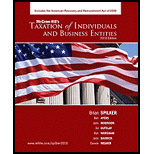
Taxation Of Individuals And Business Entities, 2010 Edition
1st Edition
ISBN: 9780073526966
Author: Brian Spilker, Benjamin Ayers, John Robinson, Edmund Outslay, Ronald Worsham, John Barrick, Connie Weaver
Publisher: McGraw-Hill/Irwin
expand_more
expand_more
format_list_bulleted
Question
Chapter 3, Problem 59P
To determine
Identify the amount that would be saved by holding the stock an additional month before selling and explain the reason that may prevent Person H from waiting to sell.
Expert Solution & Answer
Want to see the full answer?
Check out a sample textbook solution
Students have asked these similar questions
I want to this question answer for General accounting question not need ai solution
What is the material spending variance? question for accounting
Hello tutor please given General accounting question answer do fast and properly explain all answer
Chapter 3 Solutions
Taxation Of Individuals And Business Entities, 2010 Edition
Ch. 3 - 1. The goal of tax planning is to minimize taxes....Ch. 3 - Prob. 2DQCh. 3 - In this chapter we discussed three basic tax...Ch. 3 - What are the two basic timing strategies? What is...Ch. 3 - Prob. 5DQCh. 3 - What are some common examples of the timing...Ch. 3 - What factors increase the benefits of accelerating...Ch. 3 - How do changing tax rates affect the timing...Ch. 3 - Prob. 9DQCh. 3 - Prob. 10DQ
Ch. 3 - Prob. 11DQCh. 3 - What two factors increase the difference between...Ch. 3 - What factors have to be present for income...Ch. 3 - Prob. 14DQCh. 3 - Prob. 15DQCh. 3 - Prob. 16DQCh. 3 - Prob. 17DQCh. 3 - Prob. 18DQCh. 3 - Prob. 19DQCh. 3 - Explain how implicit taxes may limit the benefits...Ch. 3 - Prob. 21DQCh. 3 - Do after-tax rates of return for investments in...Ch. 3 - Prob. 23DQCh. 3 - Prob. 24DQCh. 3 - Prob. 25DQCh. 3 - What is an implicit tax and how does it affect a...Ch. 3 - Several judicial doctrines limit basic tax...Ch. 3 - What is the constructive receipt doctrine? What...Ch. 3 - Prob. 29DQCh. 3 - Relative to arms length transactions, why do...Ch. 3 - Prob. 31DQCh. 3 - Prob. 32DQCh. 3 - Prob. 33DQCh. 3 - Prob. 34DQCh. 3 - Yong recently paid his accountant 10,000 for...Ch. 3 - Billups, a physician and cash-method taxpayer, is...Ch. 3 - Prob. 37PCh. 3 - Prob. 38PCh. 3 - Prob. 39PCh. 3 - Prob. 40PCh. 3 - Prob. 41PCh. 3 - Prob. 42PCh. 3 - Prob. 43PCh. 3 - Prob. 44PCh. 3 - Prob. 45PCh. 3 - Prob. 46PCh. 3 - Prob. 47PCh. 3 - Prob. 48PCh. 3 - Prob. 49PCh. 3 - Prob. 50PCh. 3 - Prob. 51PCh. 3 - Prob. 52PCh. 3 - Prob. 53PCh. 3 - Prob. 54PCh. 3 - Prob. 55PCh. 3 - Prob. 56PCh. 3 - Prob. 57PCh. 3 - Prob. 58PCh. 3 - Prob. 59PCh. 3 - Prob. 60PCh. 3 - Prob. 61PCh. 3 - Prob. 62PCh. 3 - Prob. 63PCh. 3 - Prob. 64PCh. 3 - Prob. 65P
Knowledge Booster
Similar questions
- Two investors are evaluating Anywhere e-SIM Ltd.’s stock for possiblepurchase. They agree on the expected value of D1 and also on theexpected future dividend growth rate. Further, they agree on theriskiness of the stock. However, one investor normally holds stocksfor 2 years, while the other normally holds stocks for 10 years.Is it true that they should both be willing to pay the same price forthis stock? Explain based on how stocks are valued and provide anumerical example to support your arguments.arrow_forwardPlease need answer the accounting questionarrow_forwardWhat is the Return on Assets of these accounting question?arrow_forward
arrow_back_ios
SEE MORE QUESTIONS
arrow_forward_ios
Recommended textbooks for you





